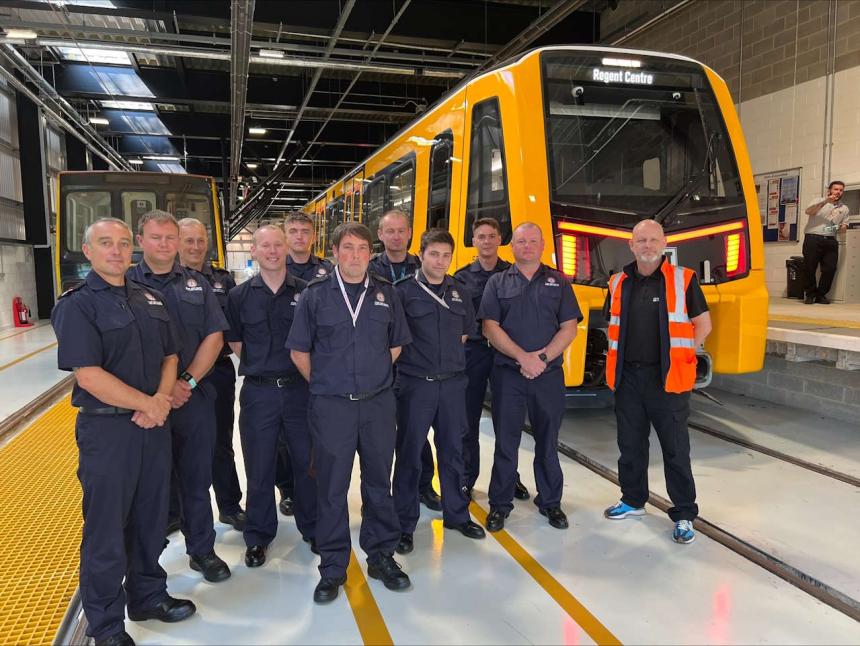Fire-fighters in North East England are the latest members of the emergency services to undergo familiarisation sessions in readiness for the launch of the new Tyne and Wear Metro trains. The new £362m fleet follows seven years of design evolution which involved consultation with 23,000 people, including Metro employees.
The fire-fighters, from Tyne and Wear Fire and Rescue Service (TWFRS), have been getting a close look at one of the new Stadler-built trains at the Nexus Learning Centre in South Shields. Nexus is the public body which owns and manages Metro. They have been running a series of training courses for all blue light services to familiarise them with the new trains in order to react to an emergency situation, should one arise in future.
The new trains are very different from the present fleet. The carriage layout is different and the location of fire extinguishers and defibrillators also differs from current trains. The fire-fighters also learnt about fire suppression systems, emergency access points to and from the driver's cab and the carriage saloon area. They were also brought up to date with power supply, battery locations, braking distances as well as the emergency alarm and intercom systems.
Three new Stadler Class 555 Metro trains, a unique design for the Newcastle-centred operation, are presently undergoing testing and driver training before they enter service. In all, 46 new trains will be built by the Swiss manufacturer Stadler, with two more trains to be delivered later this year. All new trains should be in service by the end of 2025.
Designs for the new trains were shaped by customers through an award-winning virtual reality and digital engagement. This was created by leading academics at Newcastle University's Open Lab and the new fleet has already won a Global Light Rail Award for innovation.
The air-conditioned trains have an open-plan layout, a sleekly modelled interior and the latest drive and information technology will transform journeys, set new standards for accessibility and will be energy efficient. More than 40 CCTV cameras will improve train safety.
Head of Fleet and Depot Replacement Programme at Nexus, Michael Richardson, said: “We are working closely with the Tyne and Wear Fire and Rescue Service along with the other emergency services to get them familiarised with our new trains ahead of them entering service for customers. This is vital training for the fire fighters, so that they know the layout, emergency systems and access points so that they can react effectively in the unlikely event an emergency situation should arise.
“The various different watches who are coming in to undertake this course get a good amount of time to see the new train, get on board it and examine all of its advanced systems and its fixtures and fittings. The new trains are vastly different to the current ones, so we have built this into our programme of emergency services familiarisation which takes place at our bespoke learning centre in South Shields, where we keep one of the new Stadler trains for training purposes.
“We're leaving no stone unturned as we get ready to bring the new trains into service for our customers, and working with blue light services is absolutely critical work for us.”
Head of Operational Training for TWFRS, Lee Medhurst, said: “These familiarisation sessions are crucial for our firefighters. As the roll out of the new Metro fleet replaces the old, we need to understand the differences between the two types in case we are working with either in an emergency situation. I want to thank Nexus for inviting us to their premises and for working with us to create a training package for our staff. The insight they've provided will be invaluable and the familiarisation sessions provide an opportunity for our staff to ask questions, and think about how we would adapt our response from the old fleet.”
“It's great to be able to see the difference between the old fleet and the new fleet and how technology has advanced, and been used to help keep our community safe.”
